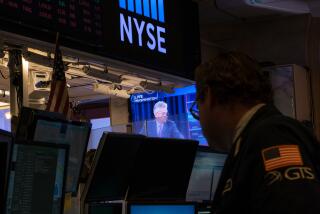Savers, Beware of Deals Offering High Yields
- Share via
With short-term interest rates in the stratosphere, it’s no wonder brokers, banks and other financial institutions are rolling out an array of new savings-oriented products touting high yields.
But buyer beware. Many of these products achieve high yields by including special temporary enhancements, gimmicks or misleading advertisements. Some may entail higher risks. Be aware of these by doing a little homework before you buy.
April in particular is a ripe month for promotion of new savings products because a lot of investor money is available that institutions want a piece of. April is a peak month for maturing of certificates of deposit, in part because many savers time their CDs to mature this month to generate cash for tax bills. Others have maturing CDs with money they pulled out of stocks following the October, 1987, stock market crash. Still others have cash from tax refunds available to deposit, or are placing money into individual retirement accounts or Keogh plans.
No doubt because of the promotional push, yields on many money market mutual funds and CDs continue to surge while yields on Treasury bills have slumped of late. For example, the average seven-day compounded yield on money market funds has risen to 9.56%, while three-month and six-month Treasury bill yields remain at 9.03% and 9.32%, respectively.
But part of those higher yields on money market funds comes from special enhancements. The biggest rage is from promoters absorbing management fees and other expenses in order to boost yields.
Of the 551 funds tracked by Donoghue’s Money Fund Report, 144 are waiving fees, editor Susan M. Cook says. That includes the three top-performing funds currently, Dreyfus Worldwide Dollar Money Market (seven-day compounded yield of 11%), Fidelity Spartan Money Market (10.88%) and Alger Money Market Portfolio (10.41%).
This is great for investors in these funds and great for Dreyfus and Fidelity, two big fund families that are heavily touting these new offerings in newspaper advertisements. But once more investors are in these funds, these and other sponsors may drop the fee subsidies, all at once or gradually. That could reduce yields as much as three-quarters of a percentage point. These funds still may yield as much or more than other funds, but there is no guarantee.
Also, in the case of Fidelity Spartan and a few others, fees are kept down because the fund charges extra for certain services that other funds provide for free. Spartan, for example, charges $10 for a book of checks and $5 for transfers to other funds. That’s OK if you plan to use the fund strictly for investment but less so if you want to use your fund for paying bills or as a holding place while you move in and out of stock funds.
Investors who want consistent winners with longer track records might instead look at Vanguard Money Market Reserves-Prime or Kemper Money Market Fund, Donoghue’s Cook suggests. Neither is subsidizing fees, but both have performed consistently among to top money funds for years, and both are currently yielding over 10%, she says.
The variety of enhancements also is growing in the CD and savings field as institutions vie for market share.
Some institutions, in part to lure IRA money, are promoting special CD rates as high as 15% or 20%. But invariably these are nothing more than introductory “teaser” rates bound to go down after a few weeks, possibly to levels lower than what you can get with conventional fixed-rate certificates.
With this and any other CD product, be sure you know what rate you are getting by asking how much money you will have at the end of the term, minus fees and expenses, says Robert Heady, editor of Bank Rate Monitor, a North Palm Beach, Fla., newsletter tracking savings products.
“The way out of misleading advertising and mumbo jumbo is to always ask that question,” he says.
Also, be aware of so-called rising rate CDs that promise to pay progressively higher rates every few months. Some institutions tout these CDs by emphasizing in their advertising the ending rate, leaving the average or beginning rate in small print, Heady says.
If total return is your primary desire, you should be careful to distinguish between CDs that offer simple interest versus those offering compounded interest. Rates on CDs with simple interest pay based only on the amount of your principal, so 11% one-year simple interest on a $1,000 deposit will pay $110 per year. Most jumbo CDs--those with minimum deposits of close to $100,000--offer simple interest.
By contrast, rates on CDs with compounded interest--paying interest on accumulated interest as well as principal--may initially be lower than those with simple interest. But over time they may well pay more, particularly those with more frequent compounding.
Also, be aware that some non-bank finance companies and savings institutions are selling subordinated notes or other savings-like instruments with higher-than-market yields. These usually carry no federal deposit insurance and are simply an unsecured IOU from the company to you, backed only by the financial strength of that company. If safety is your primary investment criteria, avoid these.
Also, some investors complain that some institutions advertise high rates but in fact offer CDs at a different, lower rate. Be aware that institutions have the right to change rates daily.
Bill Sing welcomes readers’ comments and suggestions for columns but regrets that he cannot respond individually to letters. Write to Bill Sing, Personal Finance, Los Angeles Times, Times Mirror Square, Los Angeles, Calif. 90053.
More to Read
Inside the business of entertainment
The Wide Shot brings you news, analysis and insights on everything from streaming wars to production — and what it all means for the future.
You may occasionally receive promotional content from the Los Angeles Times.










